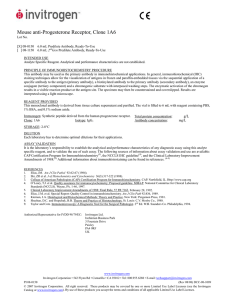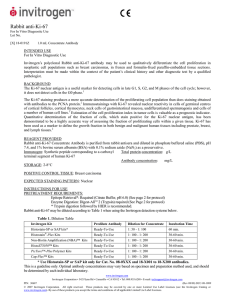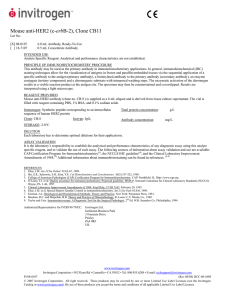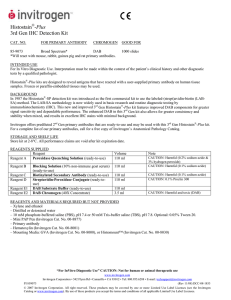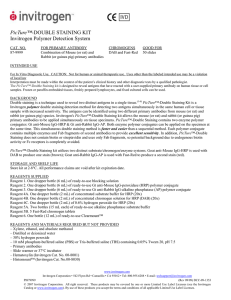Mouse anti-Neurofilament (NF-M+H)
Anuncio
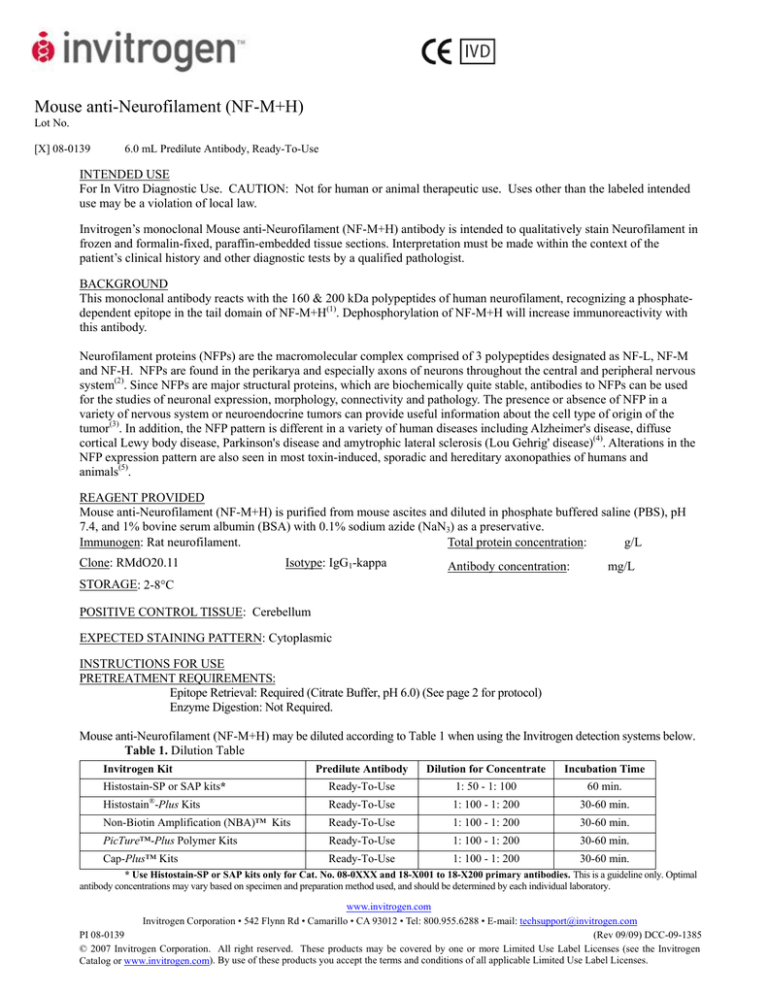
Mouse anti-Neurofilament (NF-M+H) Lot No. [X] 08-0139 6.0 mL Predilute Antibody, Ready-To-Use INTENDED USE For In Vitro Diagnostic Use. CAUTION: Not for human or animal therapeutic use. Uses other than the labeled intended use may be a violation of local law. Invitrogen’s monoclonal Mouse anti-Neurofilament (NF-M+H) antibody is intended to qualitatively stain Neurofilament in frozen and formalin-fixed, paraffin-embedded tissue sections. Interpretation must be made within the context of the patient’s clinical history and other diagnostic tests by a qualified pathologist. BACKGROUND This monoclonal antibody reacts with the 160 & 200 kDa polypeptides of human neurofilament, recognizing a phosphatedependent epitope in the tail domain of NF-M+H(1). Dephosphorylation of NF-M+H will increase immunoreactivity with this antibody. Neurofilament proteins (NFPs) are the macromolecular complex comprised of 3 polypeptides designated as NF-L, NF-M and NF-H. NFPs are found in the perikarya and especially axons of neurons throughout the central and peripheral nervous system(2). Since NFPs are major structural proteins, which are biochemically quite stable, antibodies to NFPs can be used for the studies of neuronal expression, morphology, connectivity and pathology. The presence or absence of NFP in a variety of nervous system or neuroendocrine tumors can provide useful information about the cell type of origin of the tumor(3). In addition, the NFP pattern is different in a variety of human diseases including Alzheimer's disease, diffuse cortical Lewy body disease, Parkinson's disease and amytrophic lateral sclerosis (Lou Gehrig' disease)(4). Alterations in the NFP expression pattern are also seen in most toxin-induced, sporadic and hereditary axonopathies of humans and animals(5). REAGENT PROVIDED Mouse anti-Neurofilament (NF-M+H) is purified from mouse ascites and diluted in phosphate buffered saline (PBS), pH 7.4, and 1% bovine serum albumin (BSA) with 0.1% sodium azide (NaN3) as a preservative. Total protein concentration: g/L Immunogen: Rat neurofilament. Clone: RMdO20.11 Isotype: IgG1-kappa Antibody concentration: mg/L STORAGE: 2-8°C POSITIVE CONTROL TISSUE: Cerebellum EXPECTED STAINING PATTERN: Cytoplasmic INSTRUCTIONS FOR USE PRETREATMENT REQUIREMENTS: Epitope Retrieval: Required (Citrate Buffer, pH 6.0) (See page 2 for protocol) Enzyme Digestion: Not Required. Mouse anti-Neurofilament (NF-M+H) may be diluted according to Table 1 when using the Invitrogen detection systems below. Table 1. Dilution Table Invitrogen Kit Predilute Antibody Dilution for Concentrate Incubation Time Ready-To-Use 1: 50 - 1: 100 60 min. Histostain -Plus Kits Ready-To-Use 1: 100 - 1: 200 30-60 min. Non-Biotin Amplification (NBA)™ Kits Ready-To-Use 1: 100 - 1: 200 30-60 min. Histostain-SP or SAP kits* ® PicTure™-Plus Polymer Kits Ready-To-Use 1: 100 - 1: 200 30-60 min. Cap-Plus™ Kits Ready-To-Use 1: 100 - 1: 200 30-60 min. * Use Histostain-SP or SAP kits only for Cat. No. 08-0XXX and 18-X001 to 18-X200 primary antibodies. This is a guideline only. Optimal antibody concentrations may vary based on specimen and preparation method used, and should be determined by each individual laboratory. www.invitrogen.com Invitrogen Corporation • 542 Flynn Rd • Camarillo • CA 93012 • Tel: 800.955.6288 • E-mail: techsupport@invitrogen.com PI 08-0139 (Rev 09/09) DCC-09-1385 © 2007 Invitrogen Corporation. All right reserved. These products may be covered by one or more Limited Use Label Licenses (see the Invitrogen Catalog or www.invitrogen.com). By use of these products you accept the terms and conditions of all applicable Limited Use Label Licenses. SPECIMEN PREPARATION 1. Use tissue fixed in 10% neutral buffered formalin or other fixative on regular basis, or frozen tissue sections. 2. Cut 3-4 µm sections and place on positively charged slides. 3. Dry overnight at 37° C or for 2-4 hrs at 58°C. PRETREATMENT Heat Induced Epitope Retrieval (HIER), if required 1. Deparaffinize slides. Tissue sections should be mounted on silane, poly-L-Lysine, or HistoGrip (Cat. No. 008050) coated slides. 2. Wash slides with distilled water 3 times for 2 min each. 3. Place a 1L glass (Pyrex) beaker containing 500 mL of 0.01 M citrate buffer (Cat. No. 00-5000) or EDTA solution (Cat. No. 00-5500) on a hot plate. Heat the buffer solution until it boils. (This step may be prepared before slide deparaffinization, as the buffer may take several minutes to boil). 4. Put the slides in a slide rack and place in the beaker with boiling buffer. Keep it boiling for 15 minutes. 5. After heating, remove beaker from the hot plate and allow it to cool down for at least 15-20 minutes at room temperature. 6. Rinse slides with PBS (Cat. No. 00-3000) and begin the immunostaining protocol. Enzyme Digestion, if required 1. Prewarm the enzyme of choice at 37ºC for 10 min. 2. Add the prewarmed enzyme to a tissue section and incubate at 37ºC for 10 min. 3. Wash in several changes of PBS (Cat. No. 00-3000) and begin the immunostaining protocol. RECOMMENDED MANUAL STAINING PROCEDURE 1. Submerge slides in peroxidase quenching solution and rinse with PBS. 2. Apply serum blocking solution. 3. Apply primary antibody and incubate for 30-60 min at room temperature; rinse with PBS. 4. Apply secondary antibody and incubate for 10 min at room temperature; rinse with PBS. 5. Apply enzyme conjugate and incubate for 10 min at room temperature; rinse with PBS. 6. Apply chromogen and incubate for 5-10 min at room temperature; rinse with PBS. MATERIALS REQUIRED BUT NOT PROVIDED Reagent Catalog No. HistoGrip™ 00-8050 Super PAP Pen 00-8899 Isotype Control for Rabbit or Mouse Primary Antibody 08-6199 or 08-6599 Antibody Diluent 00-3118 PBS (0.01 M PBS) 00-3000 Mayer’s Hematoxylin 00-8011 Citrate Buffer pH 6.0 (if required for HIER) 00-5000 EDTA Solution (if required for HIER) 00-5500 Digest-AllTM 1, Digest-AllTM 2, or Digest-AllTM 3 (if required for Enzyme Digestion) 00-3007 or 00-3008 or 00-3009 PicTure™-Plus polymer kit, NBA™ kit, or LAB-SA kit (Histostain®-Plus, and Cap-Plus™) (see Table 2). Chromogen/substrate (if not included in detection kit): Single Solution AEC (Cat. No. 00-1111), or DAB (Cat. No. 00-2014), or Fast-Red (Cat. No. 00-2234). 12. Mounting solution: Histomount™ (for DAB: Cat. No.00-8030), GVA (for AEC, or Fast-Red: Cat. No. 00-8000), or Clearmount™ (for AEC, DAB, or Fast-Red: Cat. No. 00-8010). 1. 2. 3. 4. 5. 6. 7. 8. 9. 10. 11. www.invitrogen.com Invitrogen Corporation • 542 Flynn Rd • Camarillo • CA 93012 • Tel: 800.955.6288 • E-mail: techsupport@invitrogen.com PI 08-0139 (Rev 09/09) DCC-09-1385 © 2007 Invitrogen Corporation. All right reserved. These products may be covered by one or more Limited Use Label Licenses (see the Invitrogen Catalog or www.invitrogen.com). By use of these products you accept the terms and conditions of all applicable Limited Use Label Licenses. RELATED PRODUCTS Table 2. Invitrogen Immunohistochemistry Detection Kits. Detection Kits Enzyme Chromogen Size 1° Ab Reactivity Histostain -Plus HRP AEC 15 mL Broad Spectrum* Histostain®-Plus HRP AEC 15 mL Mouse/Rabbit Histostain®-Plus HRP DAB 15 mL Broad Spectrum* Histostain®-Plus HRP DAB 15 mL Mouse/Rabbit Histostain®-Plus AP Fast-Red 15 mL Broad Spectrum* Histostain -Plus AP ** 60 mL Broad Spectrum* 85-8942 Histostain®-Plus HRP ** 110 mL Mouse 85-6643 Histostain®-Plus HRP ** 110 mL Rabbit 85-6743 Histostain®-Plus HRP ** 110 mL Broad Spectrum* 85-9043 Picture™-Plus Polymer Kit HRP AEC 15 mL Broad Spectrum* 87-9963 Picture™-Plus Polymer Kit HRP DAB 15 mL Broad Spectrum* Picture™-Plus Polymer Kit HRP DAB 15 mL Mouse/Rabbit Picture™-Plus Polymer Kit HRP ** 110 mL Broad Spectrum* 87-8963 Cap-Plus™ Detection Kit HRP DAB 110 mL Broad Spectrum* 87-8143 ® ® Cap- Plus™ Buffer Kit For use with Cap-Plus™ Detection Kit Invitrogen Cat. No. 85-9943 85-6543/ 85-6143 85-9643 85-9143/ 85-9243 85-9942 87-9663 87-9163/ 87-9263 87-0003 NBA™ HRP AEC 15 mL Broad Spectrum* 85-3043 NBA™ HRP DAB 15 mL Broad Spectrum* 85-4043 NBA™ HRP ** 60 mL Broad Spectrum* 85-3243 NBA™ HRP ** 110 mL Broad Spectrum* 85-3943 *Detects mouse, rabbit, rat, and guinea pig primary antibodies ** Bulk kit does not contain Chromogen/Substrate Table 3. Related Products Specificity Clone(s) or PAD Mouse anti-Neurofilament (PAN) Predilute Antibody FNP7, DA2, RMdO20.11 Mouse anti-Neurofilament (PAN) Concentrate Antibody FNP7, DA2, RMdO20.11 Mouse anti-NSE 2ndGen Predilute Antibody NSE-1G4 Mouse anti-NSE Concentrate Antibody NSE-1G4 Rabbit anti-Chromogranin A 2ndGen Predilute Antibody NS55 Rabbit anti-Chromogranin A Concentrate Antibody NS55 Rabbit anti-Synaptophysin 2ndGen Predilute Antibody Z66 Rabbit anti-Synaptophysin Concentrate Antibody Z66 Catalog Number 08-0171 18-0171 08-1196 18-0196 08-1094 18-0094 08-1130 18-0130 REFERENCES 1. Lee VM, et al. J Neurosci 7(11):3474-3488, 1987. 2. Lee VM, et al. J Neurosci. 6(8):2179-2186, 1986. 3. Trojanowski JQ, et al. Hum Pathol 15:248-257, 1984. 4. Schmidt ML, et al. Am J Pathol 136:1069-1075, 1990. 5. Schmidt ML, et al. Am J Pathol 139:53-65, 1991. TRADEMARKS Cap-Plus™, Clearmount™, Digest-All™, HistoGrip™, Histomount™, and Histostain®, NBA™, PicTure™, and Zymed® are trademarks of Zymed Laboratories, Inc. Authorized Representative for IVDD 98/79/EC: Invitrogen Ltd. Inchinnan Business Park 3 Fountain Drive Paisley PA4 9RF UK www.invitrogen.com Invitrogen Corporation • 542 Flynn Rd • Camarillo • CA 93012 • Tel: 800.955.6288 • E-mail: techsupport@invitrogen.com PI 08-0139 (Rev 09/09) DCC-09-1385 © 2007 Invitrogen Corporation. All right reserved. These products may be covered by one or more Limited Use Label Licenses (see the Invitrogen Catalog or www.invitrogen.com). By use of these products you accept the terms and conditions of all applicable Limited Use Label Licenses. Anticuerpo Neurofilamento-M+H RMdO-20 de ratón Para utilización en diagnóstico in vitro [X] 08-0139 6,0 mL de anticuerpo prediluido, listo para usar PROPÓSITO DE USO Para utilización en diagnóstico in vitro. Este anticuerpo Invitrogen tiene como objetivo tintar el antígeno en secciones de tejido congeladas e infiltradas en parafina. La interpretación de los resultados debe realizarla un patólogo cualificado, dentro del contexto de la historia clínica del paciente y otras pruebas diagnósticas. REACTIVO SUMINISTRADO El anticuerpo Neurofilamento-M+H RMdO-20 de ratón se purifica a partir de fluido de ascitis en ratón y se diluye en tampón fosfato (PBS), Ph 7,4, y seroalbúmina bovina al 1% (BSA) con azida de sodio al 0,1% (NaN3) como conservante. Inmunogén: Neurofilamento de rata Isotipo: IgG1-kappa Clon: RmdO-20 Control positivo: Cerebelo Pauta de tinción esperada: Citoplasmático ALMACENAMIENTO: 2-8°C INSTRUCCIONES DE USO REQUISITOS PARA EL PRETRATAMIENTO Eliminación del epítope: Necesario (tampón de citrato pH 6.0) (Ver protocolo en página 2) Digestión enzimática: No Necesaria Se pueden diluir los anticuerpos Neurofilamento-M+H RMdO-20 de ratón según la Tabla 1 cuando se utilicen los sistemas de detección de Invitrogen que se presentan a continuación. Tabla 1. Tabla de dilución Paquete Invitrogen Paquetes Histostain-SP o SAP * ® Paquetes Histostain -Plus Anticuerpo prediluido Dilución para concentrado Tiempo de incubación Listo para uso 1: 50 - 1: 100 60 min. Listo para uso 1: 100 - 1: 200 30-60 min. Paquete de amplificación sin biotina (NBA)™ Listo para uso 1: 100 - 1: 200 30-60 min. Paquete para polímeros PicTure™-Plus Listo para uso 1: 100 - 1: 200 30-60 min. Paquetes Cap-Plus™ Listo para uso 1: 100 - 1: 200 30-60 min. * Usar los paquetes Histostain-SP y SAP sólo para los anticuerpos primarios con nº. de catálogo 08-0XXX y del 18-X001 al 18-X200. Esto es sólo orientativo. Las concentraciones óptimas de anticuerpos pueden variar según las muestras y el método de preparación utilizado, y deberá ser determinado por cada laboratorio. PREPARACIÓN DE LA MUESTRA 1. Utilizar tejido fijado en formalina neutra tamponada al 10% u otro fijador general, o cortes de tejido congelados. 2. Hacer cortes de 3-4 µm y colocarlos sobre los portaobjetos cargados positivamente. 3. Secar durante toda la noche a 37ºC o de 2 a 4 horas a 58ºC. www.invitrogen.com Invitrogen Corporation • 542 Flynn Rd • Camarillo • CA 93012 • Tel: 800.955.6288 • E-mail: techsupport@invitrogen.com PI 08-0139 (Rev 09/09) DCC-09-1385 © 2007 Invitrogen Corporation. All right reserved. These products may be covered by one or more Limited Use Label Licenses (see the Invitrogen Catalog or www.invitrogen.com). By use of these products you accept the terms and conditions of all applicable Limited Use Label Licenses. PRETRATAMIENTO Eliminación de Epítope Inducida por Calor (HIER), en caso necesario 1. Proceder con la desparafinación de las muestras. Los cortes de tejido deberían montarse sobre portaobjetos cubiertos de silano, poli-L-lisina o HistoGrip (nº. de cat. 00-8050). 2. Lavar los portaobjetos con agua destilada 3 veces, durante 2 minutos cada vez. 3. Poner un vaso de precipitados (Pyrex) de 1 litro con 500 mL de tampón de citrato 0,01 M (nº. de cat. 00-5000) o solución de EDTA (nº. de cat. 00-5500) en una placa de calor. Calentar la solución tampón hasta que hierva. (Este paso se puede preparar antes de la desparafinación de los portaobjetos, puesto que pueden pasar varios minutos antes de que hierva el tampón). 4. Colocar los portaobjetos en una rejilla de soporte para portaobjetos y ponerlos en el vaso de precipitados con el tampón hirviendo. Déjelo hervir durante 15 minutos. 5. Después de calentar, retire el vaso de precipitado de la placa de calor y déjelo que se enfríe a temperatura ambiente durante al menos 15 ó 20 minutos. 6. Enjuagar los portaobjetos con PBS (nº. de cat. 00-3000) y proceda con el protocolo de inmunotinción. Digestión enzimática, en caso necesario 1. Calentar inicialmente el enzima de su elección a 37ºC durante 10 minutos. 2. Añadir el enzima precalentado a un corte de tejido e incubar a 37ºC durante 10 minutos. 3. Lavar en distintos baños de PBS (nº. de cat. 00-3000) y proceda con el protocolo de inmunotinción. PROCEDIMIENTO DE TINCIÓN MANUAL RECOMENDADO 1. Introducir los portaobjetos en una solución para la eliminación de la peroxidasa y enjuagar con PBS. 2. Añadir solución bloqueante con suero. 3. Añadir anticuerpo primario e incubar de 30 a 60 minutos a temperatura ambiente; enjuagar con PBS. 4. Añadir anticuerpo secundario e incubar durante 10 minutos a temperatura ambiente; enjuagar con PBS. 5. Añadir conjugado enzimático e incubar durante 10 minutos a temperatura ambiente; enjuagar con PBS. 6. Añadir cromógeno e incubar de 5 a 10 minutos a temperatura ambiente; enjuagar con PBS. MATERIALES NECESARIOS PERO NO SUMINISTRADO Reactivo 1. HistoGrip™ 2. Súper Lápiz PAP 3. Control de isotipos para anticuerpos primarios de conejo o de ratón 4. Disolvente para anticuerpos 5. PBS (PBS 0,01 M) 6. Hematoxilina de Mayer 7. Tampón de citrato con pH 6,0 (en caso necesario para HIER) 8. Solución de EDTA (en caso necesario para HIER) 9. Digest-AllTM 1, Digest-AllTM 2 o Digest-AllTM 3 Nº. de catálogo 00-8050 00-8899 08-6199 ó 08-6599 00-3118 00-3000 00-8011 00-5000 00-5500 00-3007 ó 00-3008 ó 00-3009 10. Paquete de polímeros PicTure™-Plus, paquete NBA™, o paquete LAB-SA (Histostain®-Plus, y Cap-Plus™) (véase tabla 2). 11. Cromógeno/sustrato (cuando no venga incluido en el paquete de detección): Solución simple AEC (nº. de cat. 001111), o DAB (nº. de cat. 00-2014) o Fast-Red (nº. de cat. 00-2234). 12. Solución de montaje: Histomount™ (para DAB: nº. de cat. 00-8030), GVA (para AEC, o para Fast-Red: nº. de cat. 00-8000), o Clearmount™ (para AEC, DAB, o Fast Red: nº. de cat. 00-8010). (en caso de que se necesite para la digestión enzimática) MARCAS COMERCIALES Cap-Plus™, Clearmount™, Digest-All™, HistoGrip™, Histomount™, y Histostain®, NBA™, PicTure™ y Zymed® son marcas comerciales de Zymed Laboratories, Inc. Para obtener más información vea la versión inglesa de la ficha técnica o vaya a www.invitrogen.com. TIENE ALGUNA PREGUNTA SOBRE ESTE PRODUCTO, DIRÍJASE A SU DISTRIBUIDOR LOCAL. Representante autorizado de IVDD 98/79/EC: Invitrogen Ltd., Inchinnan Business Park, 3 Fountain Drive, Paisley, PA4 9RF, UK www.invitrogen.com Invitrogen Corporation • 542 Flynn Rd • Camarillo • CA 93012 • Tel: 800.955.6288 • E-mail: techsupport@invitrogen.com PI 08-0139 (Rev 09/09) DCC-09-1385 © 2007 Invitrogen Corporation. All right reserved. These products may be covered by one or more Limited Use Label Licenses (see the Invitrogen Catalog or www.invitrogen.com). By use of these products you accept the terms and conditions of all applicable Limited Use Label Licenses. Souris anti-Neurofilament-M+H RMdO-20 Pour Utilisation de Diagnostiques In Vitro [X] 08-0139 6.0 mL Anticorps Prédilué, Prêt à l'Utilisation UTILISATION VOULUE Pour Utilisation de Diagnostiques In Vitro. Cet anticorps Invitrogen est destiné à colorer l’antigène dans des sections de tissu fixées dans du formol et incorporées dans de la paraffine. L'interprétation doit être faite par un pathologiste qualifié dans le cadre des antécédents cliniques du patient et d'autres tests de diagnostics. REACTIF FOURNI Souris anti-Neurofilament-M+H RMdO-20 est purifié à partir de fluide ascite de souris et dilué dans du Phosphate Tamponné Salin (PBS), pH 7.4, et 1% d'albumine de sérum de bovin (BSA) avec 0.1% azide de sodium(NaN3) comme préservatif. Immunogène: Neurofilament de rat Isotype: IgG1-kappa Clone: RmdO-20 Contrôle Positif : Cervelet Modèle de Coloration Attendue : Cytoplasmique STOCKAGE : à 2-8°C INSTRUCTIONS POUR L'UTILISATION PRETRAITMENTS REQUIS : Recherche d'Epitope: Requis (Tampon de Citrate pH 6.0) (Voir page 2 pour le protocole) Enzyme de digestion: Pas requis Souris anti-Neurofilament-M+H RMdO-20 peut être dilué selon le Tableau 1 lors de l'utilisation des systèmes de détection Invitrogen ci-dessous. Tableau 1. Tableau de Dilution Equipement Invitrogen Anticorps Prédilué Dilution pour Concentré Temps d'Incubation Equipements Histocoloration-SP ou SAP* Prêt à l'Utilisation. 1: 50 - 1: 100 60 min. Histocoloration®-Equipements Plus Prêt à l'Utilisation. 1: 100 - 1: 200 30-60 min. Equipements d'Amplification Non-Biotine (NBA)™ Prêt à l'Utilisation. 1: 100 - 1: 200 30-60 min. Equipements PicTure™-Plus Polymère Prêt à l'Utilisation. 1: 100 - 1: 200 30-60 min. Equipements Cap-Plus™ Prêt à l'Utilisation. 1: 100 - 1: 200 30-60 min. * Utiliser les équipements Histocoloration-SP or SAP seulement pour Cat. No.Anticorps primaires 080XXX et 18-X001 à 18-X200. Ce n'est qu'une directive. Les concentrations d'anticorps optimales peuvent variées selon le spécimen et la méthode de préparation utilisée, et doivent être déterminées par chaque laboratoire individuellement. www.invitrogen.com Invitrogen Corporation • 542 Flynn Rd • Camarillo • CA 93012 • Tel: 800.955.6288 • E-mail: techsupport@invitrogen.com PI 08-0139 (Rev 09/09) DCC-09-1385 © 2007 Invitrogen Corporation. All right reserved. These products may be covered by one or more Limited Use Label Licenses (see the Invitrogen Catalog or www.invitrogen.com). By use of these products you accept the terms and conditions of all applicable Limited Use Label Licenses. PREPARATION DE SPECIMENS : 1. Utiliser un tissu fixé dans 10% Formaline Neutre Tamponnée ou autres fixatifs de base normale, ou des sections gelées de tissu. 2. Couper des sections 3-4 µm et placer sur des lames chargées positivement. 3. Sécher toute la nuit à 37° C ou pendant 2-4 hrs à 58°C. PRETRAITMENT Recherche d'Epitope de Chaleur par Induction (HIER), si nécessaire 1. Déparaffiner les lames. Les sections de tissu doivent être montées sur du silane, du poly-L-Lysine, ou du HistoGrip (Cat. No. 00-8050) lames enduites. 2. Laver les lames dans 3 bains d'eau distillée pendant 2 min chacun. 3. Placer un bécher en verre 1L (Pyrex) contenant 500 mL de 0.01 M tampon de citrate (Cat. No. 00-5000) ou solution d'EDTA (Cat. No. 00-5500) sur une plaque chauffante. Chauffer la solution de tampon jusqu'à ébullition. (Cette étape doit être préparée antérieurement au déparaffinage des lames, car porter le tampon à ébullition peut prendre plusieurs minutes). 4. Mettre les lames sur une grille à lames et placer les dans le bécher avec le tampon en ébullition. Laisser bouillir pendant 15 minutes. 5. Après l'échauffement, retirer le bécher de la plaque chauffante et laisser le refroidir pour au moins 15-20 minutes à température ambiante. 6. Rincer les lames dans du PBS (Cat. No. 00-3000) et commencer le protocole d'immuno-coloration. Enzyme de digestion, si nécessaire 1. Préchauffer l'enzyme choisi à 37ºC pendant 10 min. 2. Ajouter l'enzyme préchauffé à la section de tissu et incuber à 37ºC pendant 10 min. 3. Laver dans plusieurs bain de PBS. (Cat. No. 00-3000) et commencer le protocole d'immuno-coloration. PROCEDURE RECOMMANDEE DE COLORATION MANUELLE 1. Plonger les lames dans une solution de perodydase refroidissant et rincer dans du PBS. 2. Appliquer une solution bloquante de sérum. 3. Appliquer un anticorps primaire et incuber pendant 30-60 min à température ambiante; rincer dans du PBS. 4. Appliquer un anticorps secondaire et incuber pendant 10 min à température ambiante; rincer dans du PBS. 5. Appliquer un enzyme conjugué et incuber pendant 10 min à température ambiante; rincer dans du PBS. 6. Appliquer un chromogène et incuber pendant 5-10 min à température ambiante; rincer dans du PBS MATERIELS NECESSAIRES MAIS PAS FOURNIS Réactif 1. HistoGrip™ 2. Super PAP Pen 3. Contrôle Isotype pour anticorps primaire de lapin ou de souris 4. Anticorps Diluant 5. PBS (0.01 M PBS) 6. Mayer Hématoxyline 7. Tampon de Citrate pH 6.0 (si nécessaire pour HIER) 8. Solution d'EDTA (si nécessaire pour HIER) 9. Digesté-LalTM 1, Digesté-LalTM 2, ou Digesté-LalTM 3 Catalogue No. 00-8050 00-8899 08-6199 ou 08-6599 00-3118 00-3000 00-8011 00-5000 00-5500 00-3007 ou 00-3008 ou 00-3009 (si nécessaire pour Digestion d'Enzyme) 10. PicTure™-Equipement Plus polymer, Equipement NBA™, ou Equipement LAB-SA (Histocoloration®-Plus, et Cap-Plus™) (voir Tableau 2). 11. Chromogène/substrat (si pas inclus dans l'équipement de détection) : Solution Unique AEC (Cat. No. 00-1111), ou DAB (Cat. No. 00-2014), or Fast-Red (Cat. No. 00-2234). 12. Solution de Monture: Histomount™ (pour DAB : Cat. No.00-8030), GVA (pour AEC, ou Rouge-Fixe : Cat. No. 00-8000), ou Clearmount™ (pour AEC, DAB, ou Rouge-Fixe : Cat. No. 00-8010). MARQUE DE FABRIQUE Cap-Plus™, Clearmount™, Digest-All™, HistoGrip™, Histomount™, et Histostain®, NBA™, PicTure™, et Zymed® sont des marques des Zymed Laboratories, Inc. Pour des informations plus détaillées, veuillez vous référer aux feuilles de données en version anglaise ou aller sur www.invitrogen.com. SI VOUS AVEZ DES QUESTIONS SUR CE PRODUIT CONTACTEZ VOTRE DISTRIBUTEUR LOCAL. Représentant Autorisé pour IVDD 98/79/EC: Invitrogen Ltd., Inchinnan Business Park, 3 Fountain Drive, Paisley, PA4 9RF, UK www.invitrogen.com Invitrogen Corporation • 542 Flynn Rd • Camarillo • CA 93012 • Tel: 800.955.6288 • E-mail: techsupport@invitrogen.com PI 08-0139 (Rev 09/09) DCC-09-1385 © 2007 Invitrogen Corporation. All right reserved. These products may be covered by one or more Limited Use Label Licenses (see the Invitrogen Catalog or www.invitrogen.com). By use of these products you accept the terms and conditions of all applicable Limited Use Label Licenses. Topo anti-Neurofilamento-M+H RMdO-20 Per uso diagnostico In Vitro [X] 08-0139 6,0 mL di anticorpo prediluito, pronto all’uso SCOPI D’UTILIZZO Per uso diagnostico In Vitro. Il presente anticorpo della Invitrogen è da usarsi per la colorazione dell’antigene in sezioni tissutali congelate fissate in formalina ed incluse in paraffina. L’interpretazione deve essere effettuata da un patologo qualificato entro il contesto dell’anamnesi clinica del paziente ed in considerazione di altri test diagnostici. REAGENTI FORNITI Topo anti-Neurofilamento-M+H RMdO-20 viene purificato da liquido ascitico di topo e diluito in soluzione salina tamponata al fosfato (PBS), pH 7,4, e 1% di albumina di siero bovino (BSA) con 0,1% sodio azide (NaN3) come conservante. Immunogeno: Neurofilamento di ratto Isotipo: IgG1-kappa Clone: RmdO-20 Controllo positivo : Cerebello Modello di colorazione previsto: Citoplasmatica CONSERVAZIONE: 2-8 °C ISTRUZIONI PER L ‘USO REQUISITI DI PRE-TRATTAMENTO: Recupero di epitopi: Richiesto (tampone citrato pH 6.0) (vedere pag. 2 per il protocollo) Digestione enzimatica : Non richiesto Topo anti-Neurofilamento-M+H RMdO-20 può essere diluito secondo la Tabella 1 quando si utilizzano i sistemi di rilevazione Invitrogen indicati sotto. Tabella 1. Tabella di diluizione Kit Invitrogen Anticorpo prediluito Diluizione per concentrato Tempo di incubazione Pronto all’uso 1: 50 - 1: 100 60 min. Kit Histostain -Plus Pronto all’uso 1: 100 - 1: 200 30-60 min. Kit di Amplificazione Non-Biotinica (NBA)™ Pronto all’uso 1: 100 - 1: 200 30-60 min. Kit PicTure™-Plus Polymer Pronto all’uso 1: 100 - 1: 200 30-60 min. Kis Cap-Plus™ Pronto all’uso 1: 100 - 1: 200 30-60 min. Kit Histostain-SP oppure SAP* ® * Utilizzare kits Histostain-SP oppure SAP esclusivamente per Cat. n. 08-0XXX e per anticorpi primari da 18-X001 a 18-X200. Queste indicazioni rappresentano soltanto una guida di massima. Concentrazioni ottimali di anticorpo possono variare in base al campione e al metodo di preparazione utilizzato, e dovrebbero pertanto essere determinate individualmente da ciascun laboratorio. www.invitrogen.com Invitrogen Corporation • 542 Flynn Rd • Camarillo • CA 93012 • Tel: 800.955.6288 • E-mail: techsupport@invitrogen.com PI 08-0139 (Rev 09/09) DCC-09-1385 © 2007 Invitrogen Corporation. All right reserved. These products may be covered by one or more Limited Use Label Licenses (see the Invitrogen Catalog or www.invitrogen.com). By use of these products you accept the terms and conditions of all applicable Limited Use Label Licenses. PREPARAZIONE DEI CAMPIONI 1. Utilizzare regolarmente tessuto fissato in 10% formalina neutra tamponata oppure in altro fissativo, o in alternativa sezioni di tessuto congelato. 2. Tagliare sezioni da 3-4 µm e collocarle su vetrini caricati positivamente. 3. Lasciare asciugare durante la notte a 37 ° C oppure per 2-4 ore a 58 °C. PRETRATTAMENTO Heat Induced Epitope Retrieval (HIER) (Recupero di epitopi mediante calore) se richiesto 1. Deparaffinizzare i vetrini. Le sezioni dei tessuti dovrebbero essere montate su vetrini rivestiti di silano, poly-LLysine, oppure HistoGrip (Cat. n. 00-8050). 2. Lavare i vetrini con acqua distillata per 3 per 2 min. ciascuno. 3. Collocare un beker di vetro (Pyrex) da 1L contenente 500 mL di 0,01 M tampone citrato (Cat. n. 00-5000) o soluzione EDTA (Cat. No. 00-5500) su una piastra scaldante. Riscaldare la soluzione tampone sino a quando bolle. (Questo passaggio può essere preparato prima della deparaffinizzazione del vetrino, poiché il tampone può richiedere diversi minuti per raggiungere il punto di ebollizione). 4. Collocare i vetrini in un rack scorrevole e metterli nel beker con tampone bollente. Far bollire per 15 minuti. 5. Dopo il riscaldamento, togliere il beker dalla piastra scaldante e far raffreddare per almeno15-20 minuti a temperatura ambiente. 6. Risciacquare i vetrini con PBS (Cat. n. 00-3000) ed iniziare il protocollo di immunocolorazione. Digestione Enzimatica, se richiesto 1. Preriscaldare l’enzima scelto a 37 ºC per 10 min. 2. Aggiungere l’enzima preriscaldato ad una sezione di tessuto ed incubare a 37 ºC per 10 min. 3. Lavare effettuando diversi cambi di PBS (Cat. n. 00-3000) ed iniziare il protocollo di immunocolorazione. PROCEDURA DI COLORAZIONE MANUALE RACCOMANDATA 1. Immergere i vetrini in soluzione quenching di perossidasi e risciacquare con PBS. 2. Applicare soluzione siero bloccante. 3. Applicare Anticorpo primario ed incubare per 30-60 min a temperatura ambiente; risciacquare con PBS. 4. Applicare Anticorpo secondario ed incubare per 10 min a temperatura ambiente; risciacquare con PBS. 5. Applicare enzima coniugato ed incubare per 10 min a temperatura ambiente; risciacquare con PBS. 6. Applicare cromogeno ed incubare per 5-10 min a temperatura ambiente; risciacquare con PBS. MATERIALI NECESSARI MA NON FORNITI Reagente 1. HistoGrip™ 2. Super PAP Pen 3. Controllo dell’isotipo per anticorpo primario di coniglio o topo 4. Anticorpo diluente 5. PBS (0,01 M PBS) 6. Ematossilina di Mayer 7. Tampone citrato pH 6.0 (se richiesto per HIER) 8. Soluzione EDTA (se richiesto per HIER) 9. Digest-AllTM 1, Digest-AllTM 2, o Digest-AllTM 3 Catalogo n. 00-8050 00-8899 08-6199 o 08-6599 00-3118 00-3000 00-8011 00-5000 00-5500 00-3007 oppure 00-3008 oppure 00-3009 10. Kit di polimeri PicTure™-Plus, NBA™ kit, o LAB-SA kit (Histostain®-Plus, e Cap-Plus™) (cfr. Tabella 2). 11. Cromogeno/substrato (se non incluso nel kit per il rilevamento): Soluzione singola AEC (Cat. No. 00-1111), oppure DAB (Cat. n. 00-2014), oppure rosso solido (Cat. n. 00-2234). 12. Soluzione montante: Histomount™ (per DAB: Cat. n.00-8030), GVA (per AEC, oppure rosso solido: Cat. n. 008000), oppure Clearmount™ (per AEC, DAB, oppure rosso solido: Cat. n. 00-8010). (se richiesto per digestione enzimatica) MARCHI REGISTRATI Cap-Plus™, Clearmount™, Digest-All™, HistoGrip™, Histomount™, e Histostain®, NBA™, PicTure™, e Zymed® sono marchi registrati di Zymed Laboratories, Inc. Per informazioni più dettagliate vi preghiamo di consultare la versione inglese del catalogo oppure visitate il sito www.invitrogen.com. SE AVETE DOMANDE SUL PRODOTTO, CONTATTATE IL VOSTRO DISTRIBUTORE PIÙ`VICINO. Rappresentante Autorizzato per IVDD 98/79/EC: Invitrogen Ltd., Inchinnan Business Park, 3 Fountain Drive, Paisley, PA4 9RF, UK www.invitrogen.com Invitrogen Corporation • 542 Flynn Rd • Camarillo • CA 93012 • Tel: 800.955.6288 • E-mail: techsupport@invitrogen.com PI 08-0139 (Rev 09/09) DCC-09-1385 © 2007 Invitrogen Corporation. All right reserved. These products may be covered by one or more Limited Use Label Licenses (see the Invitrogen Catalog or www.invitrogen.com). By use of these products you accept the terms and conditions of all applicable Limited Use Label Licenses. Maus Anti-Neurofilament-M+H RMdO-20 Für In Vitro Diagnostischen Gebrauch [X] 08-0139 6.0 mL Vorverdünnter Antikörper, gebrauchsfertig BEABSICHTIGTER NUTZEN Für In Vitro Diagnostischem Gebrauch. Dieser Antikörper von Invitrogen ist zur Färbung des Antigens in gefrorenen und formalinfixierten, in Paraffin eingebetteten Gewebeschnitten vorgesehen. Die Interpretation muss im Zusammenhang mit der klinischen Vorgeschichte des Patienten und anderen Diagnostiktests eines qualifizierten Pathologen vorgenommen werden. REAGENS GELIEFERT Maus Anti-Neurofilament-M+H RMdO-20 ist gereinigt von Maus asciter Flüssigkeit und verdünnt in Phosphatgepufferter Salzlösung (PBS), pH 7.4, und 1%igem Rinder Serum Albumin (BSA) mit 0.1% Sodium Azide (NaN3) als ein Konservierungsmittel. Immunogen: Rattenneurofilament Isotyp: IgG1-kappa Klon: RmdO-20 Positive Kontrolle: Cerebellum Erwartetes Färbungsmuster: Cytoplasmatisch LAGERUNG: 2-8°C BENUTZUNGSANLEITUNG VORBEHANDLUNGS ERFORDERNISSE Epitop Wiedergewinnung : Erforderlich (Citrat Puffer pH 6.0) (Siehe Seite 2 für Protokoll) Enzym Verdauung: Nicht benötigt Maus Anti-Neurofilament-M+H RMdO-20 kann entsprechend Verzeichnis 1 verdünnt werden, wenn das Invitrogen Nachweis System unten benutzt wird. Tabelle 1. Verdünnungs Verzeichnis Invitrogen Kit Vorverdünnter Antikörper Verdünnung für Konzentrat Inkubationszeit (Min.) Histostain-SP oder SAP Kits* gebrauchsfertig. 1: 50 - 1: 100 60 Min. Histostain®-Plus Kits gebrauchsfertig. 1: 100 - 1: 200 30-60 Min. Nicht-Biotin Verstärkungs (NBA)™ Kits gebrauchsfertig. 1: 100 - 1: 200 30-60 Min. PicTure™-Plus Polymer Kits gebrauchsfertig. 1: 100 - 1: 200 30-60 Min. Cap-Plus™ Kits gebrauchsfertig. 1: 100 - 1: 200 30-60 Min. * Benutzen Sie Histostain-SP oder SAP Kits nur für Cat. Nr. 08-0XXX und 18-X001 bis 18-X200 Primäre Antikörper. Dies ist nur eine Richtlinie. Optimale Antikörper Konzentrationen können variieren, basierend auf benutzten Proben und Präparationsmethoden und sollten von jedem individuellen Laboratorium bestimmt werden. www.invitrogen.com Invitrogen Corporation • 542 Flynn Rd • Camarillo • CA 93012 • Tel: 800.955.6288 • E-mail: techsupport@invitrogen.com PI 08-0139 (Rev 09/09) DCC-09-1385 © 2007 Invitrogen Corporation. All right reserved. These products may be covered by one or more Limited Use Label Licenses (see the Invitrogen Catalog or www.invitrogen.com). By use of these products you accept the terms and conditions of all applicable Limited Use Label Licenses. PROBEN PRÄPARATION 1. Gewebe in 10%igem neutral gepufferten Formalin fixiert oder anderen Fixiermitteln auf regelmäsiger Basis benutzen oder gefrorene Gewebesetionen. 2. 3-4 µm Sektionen schneiden und sie auf positiv gesättigte Objektträger legen. 3. Über Nacht bei 37° C trocknen oder für 2-4 Std. bei 58°C. VORBEHANDLUNG Hitze Induzierte Epitop Wiedergewinnung (HIER), wenn erforderlich 1. Objektträger deparaffinisieren. Gewebesektionen sollten auf Silane, Poly-L-Lysine oder HistoGrip präpariert werden (Cat. Nr. 00-8050) beschichtete Objektträger. 2. Objektträger mit destilliertem Wasser für jeweils 2 Min. waschen. 3. Ein 1L Becherglas (Pyrex), das 500 mL von 0.01 M Citrat Puffer (Cat. Nr. 00-5000) oder EDTA Lösung (Cat. Nr. 00-5500) enthält auf eine heiße Platte legen. Die Pufferlösung erhitzen bis sie kocht. (Dieser Schritt kann vor der Objektträger Deparaffinisierung vorbereitet werden, da der Puffer mehrere Minuten braucht, bevor er kocht.) 4. Die Objektträger in ein Objektträgergestell setzen und das Becherglas mit dem kochenden Puffer plazieren. Es 15 Minuten kochen lassen. 5. Nach der Erhitzung das Becherglas von der heissen Platte entfernen und es für mindestens 15-20 Minuten bei Zimmertemperatur abkühlen lassen. 6. Die Objektträger mit PBS (Cat. Nr. 00-3000) spülen und das Immunofärbungs-Protokoll beginnen. Enzym-Verdauung, wenn benötigt 1. Das Enzym der Wahl bei 37ºC für 10 Min. vorwärmen 2. Das vorwärmte Enzym auf eine Gewebsektion geben und bei 37ºC für 10 Min. inkubieren. 3. In mehreren Wechseln von PBS (Cat. Nr. 00-3000) waschen und das Immunofärbungsprotokoll beginnen. EMPFOHLENES MIT DER HAND FÄRBUNGSVERFAHREN 1. Die Objektträgert in Peroxidase Löschungslösung tauchen und mit PBS spülen. 2. Die Serums-Blockierungslösung dazugeben. 3. Primären Antikörper dazugeben und für 30-60 Min. bei Zimmertemperatur inkubieren; mit PBS spülen. 4. Sekondären Antikörper dazugeben und für 10 Min. bei Zimmertemperatur inkubieren; mit PBS spülen. 5. Enzymkonjugat dazugeben und für 10 Min. bei Zimmertemperatur inkubieren; mit PBS spülen. 6. Chromogen dazugeben und für 5-10 Min. bei Zimmertemperatur inkubieren; mit PBS spülen. BENÖTIGTE, ABER NICHT GELIEFERTE MATERIALIEN Reagens Katalog Nr. 1. HistoGrip™ 00-8050 2. Super PAP Pen 00-8899 3. Isotyp Kontrolle für Primären Antikörper von Kaninchen oder Maus 08-6199 oder 08-6599 4. Antikörper Verdünner 00-3118 5. PBS (0.01 M PBS) 00-3000 6. Mayer’s Haematoxylin 00-8011 7. Citrat Puffer pH 6.0 (wenn für HIER benötigt) 00-5000 8. EDTA Lösung (wenn benötigt für HIER) 00-5500 9. Diget-AllTM 1, Digest-AllTM 2, oder Digest-AllTM 3 (Wenn benötigt für Enzym Verdauung) 00-3007, 00-3008 oder 00-3009 10. PicTure™-Plus Polymer Kit, NBA™ Kit, oder LAB-SA Kit (Histostain®-Plus, und Cap-Plus™) (siehe Verzeichnis 2). 11. Chromogen/Substrat (wenn nicht im Nachweis Kit inbegriffen): Einzel Lösung AEC (Cat. Nr. 00-1111), oder DAB (Cat. Nr. 00-2014), oder Lichtstark-Rot (Cat. Nr. 00-2234). 12. Präparierungslösung: Histomount™ (für DAB: Cat. No.00-8030), GVA (für AEC, oder Lichtstark-Rot: Cat. Nr. 00-8000), oder Clearmount™ (für AEC, DAB, oder Lichtstark-Rot: Cat. Nr. 00-8010). WARENZEICHEN Cap-Plus™, Clearmount™, Digest-All™, HistoGrip™, Histomount™, und Histostain®, NBA™, PicTure™, und Zymed® sind Warenzeichen der Zymed Laboratories, Inc. Für genauere Information beziehen Sie sich bitte entweder auf die englische Version auf der Datenplatte oder auf www.invitrogen.com. SOLLTEN SIE IRGENDWELCHE FRAGEN ÜBER DIESES PRODUKT HABEN, WENDEN SIE SICH BITTE AN IHREN ÖRTLICHEN VERTEILER. Bevollmächtigter Repräsentant für IVDD 98/79/EC: Invitrogen Ltd., Inchinnan Business Park, 3 Fountain Drive, Paisley, PA4 9RF, UK www.invitrogen.com Invitrogen Corporation • 542 Flynn Rd • Camarillo • CA 93012 • Tel: 800.955.6288 • E-mail: techsupport@invitrogen.com PI 08-0139 (Rev 09/09) DCC-09-1385 © 2007 Invitrogen Corporation. All right reserved. These products may be covered by one or more Limited Use Label Licenses (see the Invitrogen Catalog or www.invitrogen.com). By use of these products you accept the terms and conditions of all applicable Limited Use Label Licenses.
